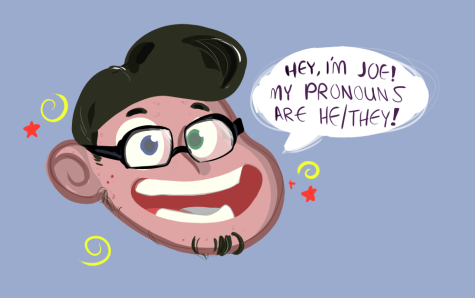What is a pronoun? From Birmingham University’s definition, a pronoun is “a linguistic tool that we use to refer to people, such as they/them/theirs, she/her/hers, he/him/his or even zie/zir/zirs (and the list goes on). Someone’s pronouns inform us how to best refer to and honor them.”

I would also like to add to this definition by stating that someone can also have mixed pronouns, such as she/they/theirs, and he/her/xirs. If someone has mixed pronouns, make sure to use them both (or all) as much as possible.
How do you know your preferred pronouns? Well, some people don’t have to question their pronouns, others may have to explore what feels right to them. Other people may be fluid with their gender identity, and change their preferred pronouns every day! All of these different pronoun journeys are just fine and valid. Your pronouns are just what feels right for you, there are no wrong answers. It may take some time, research and exploration to figure it all out, there is no rush!
Close to all individuals get uncomfortable or hurt if they are referred to with the wrong pronouns, and this does not exclude cisgender people. To avoid this, here are some ways to help normalize pronouns in the classroom:
Name tags: At the beginning of the school year, every student could make a name tag with their favorite food, class, and their preferred pronouns. Collect the name tags and write the students’ preferred pronouns on the attendance sheet, along with the students’ preferred name if they have one.

Announce that if someone changes their preferred pronouns at any time throughout the school year, to tell the teacher that they have done so. This way, you or the substitute will not fumble up and potentially misgender a student.
Sharing personal pronouns may be uncomfortable for a student, and that’s okay! Not every individual will know or want to share their preferred pronouns, and pronouns can change! Even if a student does not wish to talk about it one-on-one with the teacher, there are ways to avoid making someone feel uncomfortable when referring to them.
Incorporating gender-neutral language in the classroom greetings is always a great thing to do. For example, instead of “Welcome, boys and girls!” or “Hey ladies!”, use “Welcome, everyone!” or “Hello y’all!” This one is easy to incorporate into your language, and it includes everyone’s’ gender identities.
Word of advice, teachers: never acknowledge someone’s dead-name to the classroom. Example: “I didn’t know your name was Jane, and not Joe!” This will out someone almost immediately. Outing can lead to resentment, outcasting, and potential harm to that student. To avoid outing a student, make sure you know their preferred name. Never assume. Most importantly, think before you speak.
Pronouns, identities, and self expression may be hard to understand at first. Everyone starts off that way! All you need to do to show your support is to research, reach out, and to be open-minded.








